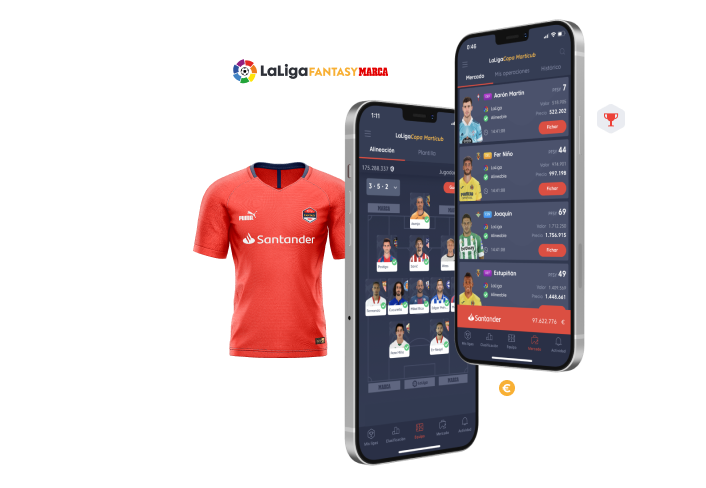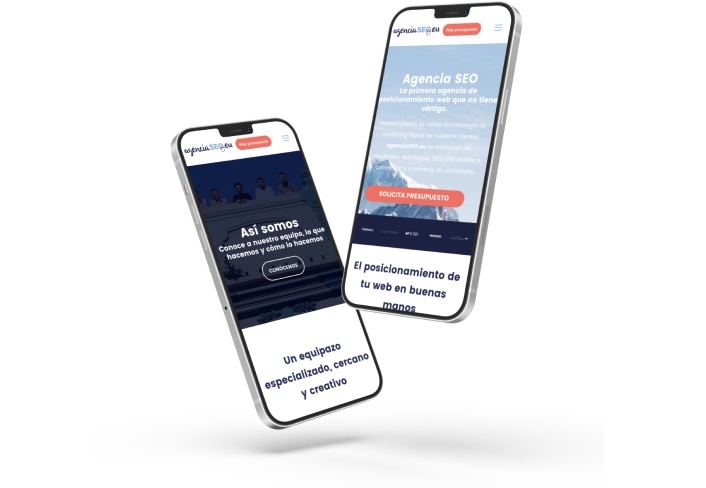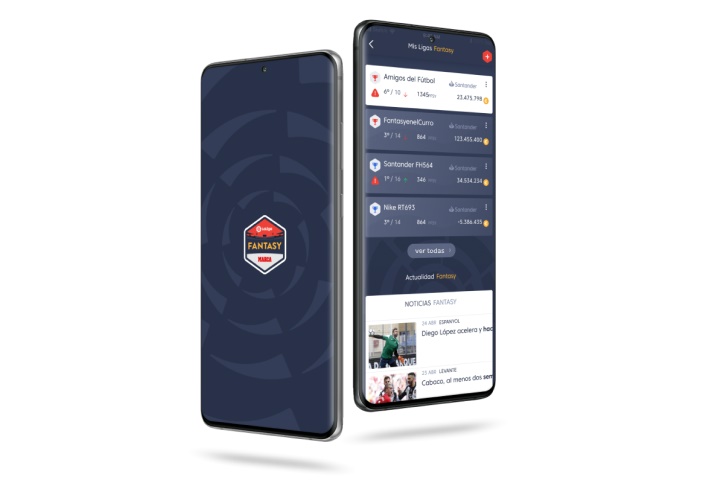Mobile game development in the hands of the best professionals
We connect you with the ideal team for the design and development of your mobile game. Our experience is at your disposal. Shall we get started?

We turn your game app idea into reality
Over the years, we’ve developed many custom mobile games. These are just a few popular examples but we can certainly help you with your app idea too.
Cross-platform
Native
Web App
Or whatever you need!
Create your game app with Yeeply
You’re only four steps away from getting your app game project off the ground. Shall we get started?
1. Tell us about your idea
Give us detailed information about your mobile game.
2. We find you the perfect team
Our algorithm takes care of finding the right experts to build your game.
3. Receive a custom quote
Receive a custom quote (or several). Negotiate with the team and sign when you’re ready.
4. Let’s get your game on!
We take care of the paperwork so you can focus on the execution of the project.

Our goal is to find you the perfect team to develop your game app
Discover more
1. How to create a successful mobile game
You are likely reading this because you have already made a decision: you want to transform a great idea of yours into a tangible business. Please bear in mind that, if you want to create a successful mobile game, you must have a good idea to start with. And you will also need to stick to a proper roadmap to ensure its success.
This roadmap is about taking the proper steps regarding strategy, planning, and action, as well as about setting the objectives that will define the project.
However, let’s first have a look at the reasons why we should develop a mobile game. The following three are compelling arguments based on facts.
- The market for mobile games shows an unstoppable growth: the share of mobile games in the overall gaming market is expected to rise to 59% in 2021. From now on to 2024, the mobile game market is expected to grow at a yearly 2.9% rate, which translates into revenue amounting to over 56 billion dollars.
- The number of people playing mobile games is also on the rise: up to 2.7 billion in 2021! If you had imagined that most of them are in Asia, you’re right: 620 million of them are in China, which is the world’s largest market for mobile games. However, let’s not neglect the fact that there are also 210 million mobile gamers in the United States. In any case, the markets awaiting your product are huge.
- And last but not least: the market for mobile games comprises all ages, genders, and game genres. According to age groups, the largest group is the one consisting of people aged 25-34 (30%), followed by those aged 35-44 (24%) and 45-54 (20%).
1.1 What kinds of mobile games are there?
Action and sports video games may predominate on game platforms and PCs, but mobile devices (chiefly smartphones and tablets) have other prominent game genres. Let’s have a look at these genres and how widespread some of them are:
- Casual: with a solid 58% penetration rate, this genre is by far the most played by Android users. Some examples of this kind of games include extremely well-known Candy Crush and free gambling games resembling bingo games or slot machines.
- Puzzle: it’s the second most played genre and amounts to over 30% of worldwide mobile game downloads. Games based on popular board games such as pachisi, dominoes, scrabble, letters, puzzles, and numbers make up the very heart of this genre.
- Action: these games require large screens to be able to enjoy an optimal user experience. This genre accounts for 11% of the market share within the mobile gaming industry. Its subgenres include platform games, shooting games, fighting games, battle royal games, stealth games, and the like.
- Other: besides the previous genres, there are plenty of other ones like arcade, adventure, racing, sports, strategy, RPG, MOBA (Multiplayer Online Battle Arena), words, cards, or trivia.
1.2 What gamification elements can be implemented?
Creating a mobile game or introducing some gamification elements into a mobile app comes as an opportunity to obtain more users while growing sustainably.
Five key elements in good gamification
- Rewards: offering a reward for completing a task or for attaining a certain level is of paramount importance.
- Virtual goods: they are similar to rewards but entail a long-term value.
- Badges: obtaining them is a good reason for facing challenges. These may be petty elements but they convey your support to your users.
- Ranking lists: these encourage users to keep their activity up to have their names eventually entered into a ranking of best players. Having a player ranking will improve the game’s overall user experience.
- Progress screen: regardless of the kind of app, including a small image displaying the percentage of progress made by your users will make them crave attaining 100%.
Four tips to take advantage of gamification
- Set goals: it’s important to have a plan and choose well the elements that will improve your user’s experience.
- Create value: try to offer useful rewards and introduce interesting features on the same wavelength as your customers that promote their interaction with the game.
- Enable loop sharing: Make sharing your app or its contents easy to get your customers to spread it and—above all—give them good reasons to do so.
- Try to keep everything simple: mobile games with simple dynamics are the most successful ones—just look at Angry Birds or Candy Crush. If your game’s dynamics are a bit more complex, make sure to have its difficulty increase little by little.
1.3 Guide on how to create games with a good plot
There is no single secret formula leading to a good game plot. The key lies in how you approach the scriptwriting process. There are two elements that every good story must contain to underpin it.
- Player/character dynamics: the player must merge with the character. It’s best to allow the player to see all that’s going on, be aware of everything, and feel that he/she is in control.
- An interactive space for the player to explore: the user will want to take action, touch, collect, explore, choose… Offering him/her all this interactivity is essential.
When creating your script, a good starting tip is to focus first on establishing the overall story and then narrow it down to its details. We suggest you follow these seven steps:
- Step 1. Outline the main story. You have to draw up an outline where the most important events experienced by the characters are summed up, regardless of whether the story is a single linear plot with a defined beginning and end or contains several possible endings.
- Step 2. Decide what kind of game it will be. There are quite a bunch of options available: action, adventure, RPG, shooting, puzzles… Please take your time with this step because it’s an important decision that will impact and frame the entire story.
- Step 3. Create your world. Remember that your players will be more immersed in the virtual environment you create than in the real environment that surrounds them while they play. They will see and know more about this virtual world than about its characters. Try also to determine how much of it they will be able to explore.
- Step 4. Create your game’s main characters. It’s now time to create your game’s main character, its main foes, its companions, etc. The greatest difficulty resides in introducing behavioural variations and making them all interact smoothly.
- Step 5. Create a flow chart depicting the game’s main plot. It must show all possible ramifications in the main story, as well as minor changes and side quests.
- Step 6. Start writing. Cutscenes (which display plenty of information or dialogues and enable little interaction) always proves a good way to narrate the story before diving into the game’s main action or its side missions.
- Step 7. Add side quests, NPCs (non-playable characters), and items. NPCs are characters with who your player can interact. They can give out clues, reveal information, offer side quests, and the like. If your story is long, this is a fitting way to introduce side quests associated with specific parts of the world or with certain characters. Include objects that differentiate your game from others: notes, letters, jewellery with a story behind it, derelict houses, etc.
2. Mobile game development tutorial
Good strategy and planning have gotten you this far. However, now you’re going to learn more about how to create the game app that is the best match for the important basic aspects that you have already defined.
2.1 Graphic design and UI/UX
Graphic appearance is what’s going to set your game apart from others. The amount of different styles to choose from is almost boundless. Minimalistic, comic, or retro are just some examples of these mobile game aesthetics and drawing styles.
User Interface (UI)
The user interface is the exact point where the user and the game meet. It will be decisive for your game to be perceived as a quality game. A good UI design guides players directly or intuitively so that they can navigate your game’s world trouble-free.
UI can be regarded as the element that aims at delivering an enjoyable user experience by merging graphic design with the game’s content and architecture. The creative aspect of UI design will define all the elements with which the user will interact: icons, buttons, scenes, screens, menus, etc.
User Experience (UX)
User interface (UI) and user experience (UX) should both seek simplicity and offer intuitive navigation adapted to the player’s profile.
The key leading to a good UX design is to approach it as a comprehensive process that combines aesthetics and functionality, enabling players to enjoy playing the game, spend hours on it, and ultimately recommend it to friends.
2.2 The technical development process of a mobile game
The development stage is the most technical and important part of the mobile game creating process. There are three kinds of development approaches to choose from:
- Native: native games are developed for a specific operating system. You’ll have to create two different versions of your game if you want it to be available for both Android and iOS. Native development allows you to take full advantage of a mobile device’s capabilities, which can turn out to be a significant advantage in more complex games.
- Hybrid: hybrid games adapt to any mobile device and run on a combination of web technologies such as HTML, CSS, and JavaScript, which are packaged in a native container ready for distribution in app stores.
- Web: these games use HTML5, a markup language (based on tags) that enables creating web content with multimedia support (both audio and video). Many games are created with HTML5 because it’s a cheap and relatively straightforward development option that adapts well to different kinds of screens.
Programming languages: which one to choose according to the kind of game
Resorting to tailored programming is almost compulsory if you want to unravel a powerful game development. And your mobile game’s complexity will ultimately be what is going to determine which language is required for this development.
Java is one of the most widely used programming languages for developing games because it offers frameworks like JMonkeyEngine or Ardor 3D.
JavaScript also plays an important role in game development due to the high capability of HTML5 and the 2D and 3D graphics libraries, especially when being run on a browser.
As for C#, it’s also one of the most popular programming languages for developing mobile games since Unity (one of the most widely used game development platforms) supports C# as a native language.
2.3 The testing stage
Testing the app both internally and externally is more than recommended: it is rather essential. Testing must be carried out to comply with the following aims:
- To find all possible errors and bugs the game may have and get them fixed to ensure that its final version is stable and runs smoothly.
- To avoid a bad user experience that could trigger a flood of negative comments and ratings from players.
Also, remember to check that the game works correctly on all the devices it is intended for and under all kinds of extraordinary conditions..
2.4 Time to launch! But afterwards, the work must go on…
The end of the development process is also a beginning. That’s right, you’ve read correctly! At this point, you’re finally going to publish your game in an app store but there is still work to get done: the next thing will be to make it stand out from the myriad of other pre-existing mobile games. That’s why we’ll now suggest 10 ASO tips to help you position your mobile game in Apple’s App Store or Google Play.
- Do some research on your target customer and on your rivals: what’s special about what you deliver to your users and which specific keywords are your industry rivals using?
- Choose a proper name for your game: apps including keywords in their name rank best. Keep the name short and flashy and add your keywords to it by using a hyphen or a colon.
- Maximise your keywords: check the text limits that the store listing has in place for each field, choose your keywords wisely, and make the most out of the space provided. The more information you provide the better.
- Create an enthralling description: elaborate your description having in mind what is the value that you are bringing to your users and choose the right keywords.
- Draw attention to your game by having a showy and inviting icon: making a good first impression matters. Just an extra tip: take a look at the names of top-ranked apps and find out what they have in common.
- Include screenshots and videos: they don’t have an impact on positioning but will surely get you more conversions because potential users will be able to have a look at the app before downloading it.
- Adjust your app to the local market: don’t forget to translate your game into the language spoken in the market you are targeting.
- Increase traffic through external promotion: use all the tools that are currently available (social media, blogs, content marketing, etc.).
- Update your game frequently: top-ranked apps get updated every 30-40 days. However, please be careful with iOS apps because their ranking number in the App Store restarts when updated.
- Encourage ratings and comments on your app: the best possible advertising is the one carried out by your users. You can offer them freebies of some kind for posting their comments or sharing your app.
As you may see, you still have some work to wrap up ahead of you! However, don’t rest on your oars because your mobile game’s success does not depend exclusively on ASO. Work on other channels besides the app stores to have your game gain visibility. These are some ideas to do so:
- Create a landing page or a microsite: although games are most commonly downloaded from the stores themselves, 1 in 4 people search for new games on web browsers. To address this, you can create a simple website (a landing page will suffice) containing some screenshots of the game and the keywords your users will be looking for. Include a promo video and links to the app stores and your social media pages.
- Index your game app: by doing this, potential users can click on a Google or Safari search listing on their tablets or smartphones and go straight to the app store. It can be done for Android and iOS alike.
- Find out specialised media: find out which bloggers and YouTubers reach your target audience. Introduce them to your game, get them to review it, and build a community.
- Launch PPC (pay-per-click) campaigns: these campaigns use services like Google Ads or Facebook Ads to deploy segmented advertising that reaches your potential users effectively on search engines and social media.
3. Analysis: the cost of creating a mobile game
Knowing exactly how much a mobile game will cost is quite complicated, as it will depend on many elements. If you are looking for an exact figure, it’s always best to contact a professional who can give you a customised budget (Yeeply can also provide you with one through this link—no strings attached!).
3.1 What factors affect a mobile game’s final cost?
We are now going to talk about money, so try to avoid missing out on any of the following.
- Time: the delivery deadline will determine the project’s cost so, if you are on a tight budget, the deadline will most likely have to be a bit more flexible than the budget.
- Quality and features: as a rule of thumb, the more details and features to implement, the higher the app’s cost.
- Kind of development: as we have already discussed, there are several options available (native, hybrid, and web) and they don’t come at the same cost. The project will be more expensive if you need to develop a native app for Android and then another one for iOS. Both hybrid and web (HTML5) apps are cheaper to develop — especially the latter — but they also perform worse than native apps.
- Operating System: creating an application for Android is not the same as for iOS. The hourly hiring cost of an iOS developer is usually higher.
- Release costs: uploading your game to the app stores also entails a cost and its positioning will also involve an initial marketing investment.
- Maintenance: it’s always a good idea to hire your game’s development team for a few fixed maintenance hours to correct possible bugs that may arise and to update the game.
3.2 How to monetise a mobile game
Obtaining a financial benefit may very well be one of your main objectives. However, you must be careful and proceed in a balanced manner when it comes to advertising, as you must avoid pestering your users with too much of it. There are three main game monetisation models:
- Free option (free download): this option will attract more users and can earn you more money in the long run through ads and in-game purchases. Remember that users are much more likely to click on ads shown to them on apps than on websites.
- Premium option (paid-for download): this option will probably generate more income in the short term but keep in mind that it will be harder for the game to attain great popularity.
- Freemium option (free download and in-app purchases): under this model, monetisation is carried out through elements that can be purchased within the app, which normally provide some kind of advantage in the game. It’s the most widely used monetisation model and the one that generates the most income for games and other applications.
3.3 #YeeplyTip 1: tools you can use to create a mobile game
There are truly interesting options available that allow you to create a simple game by using predefined templates and actions. But let’s not forget that these unsophisticated tools are naturally also the most technically-limited.
GameSalad or Stencyl, for instance, are a couple of them that enable you to create this kind of game.
However, if you are more acquainted with game development and want to develop a somewhat more complex mobile game, GDevelop or GameMaker Studio may be good options for you. The latter is very intuitive.
Finally, if you are looking for something on the upper tier of mobile game professional development, you should go for one of the two best tools available: Unity and Unreal Engine. Unity is a very complete tool that guarantees professional results. And Unreal Engine is even more powerful and is presumably the most professional option for developing great games.
3.4 #YeeplyTip 2: professional profiles you should hire
It comes without saying that if you seek professional results (which don’t feel “prefabricated” and are not heavily reliant on advertising) you will have to rely on a good development team. Some of the professional profiles involved in the whole creation process (comprising design, development, and launch) are:
- Graphic designer
- UX expert
- UI expert
- Developer
- Digital marketing expert
- ASO expert
Did you know that Yeeply is the platform where you can find all these professionals? We are a marketplace that brings together the best digital talent so that you can find on a single spot the perfect team that will make your game come true. Shall we talk?








